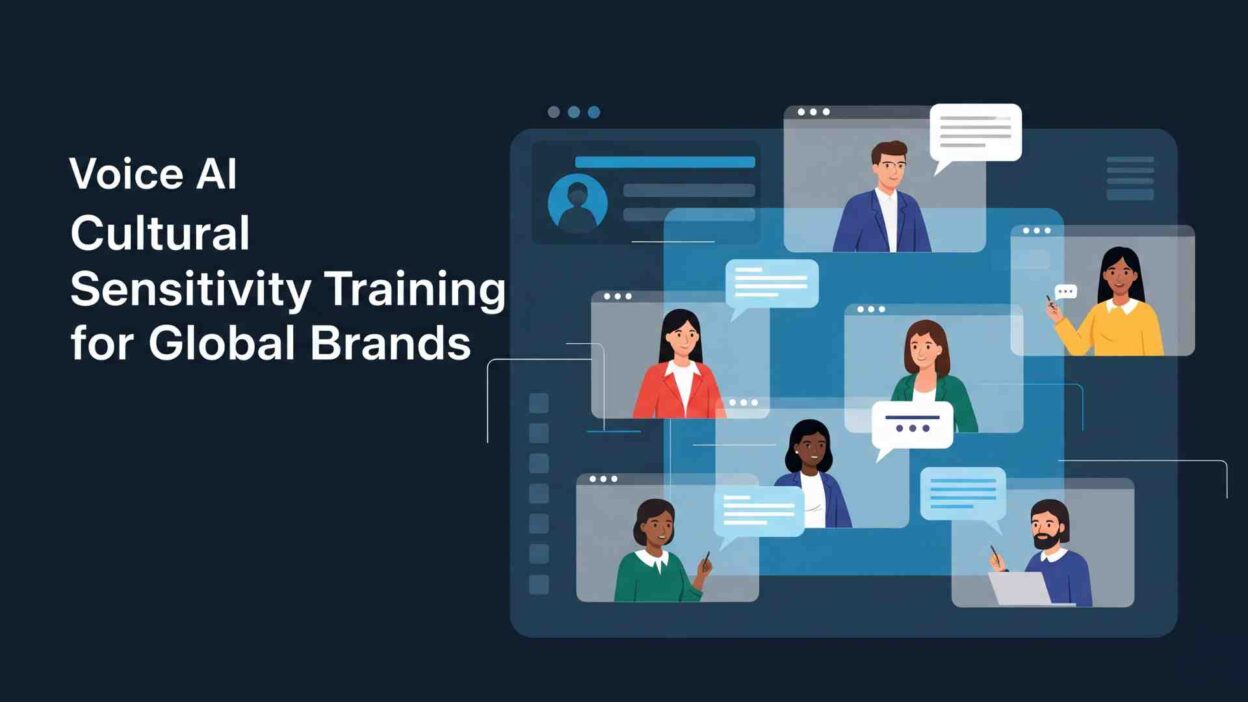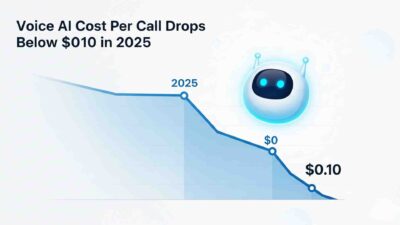TL;DR Voice AI cultural sensitivity represents the cornerstone of successful global brand communication in today’s interconnected marketplace. Multinational companies face mounting pressure to communicate respectfully across diverse cultural landscapes. Cultural missteps can damage brand reputation permanently within minutes of going viral on social media.
Table of Contents
Modern consumers expect brands to understand their cultural values deeply. Voice AI systems must navigate complex cultural nuances without causing offense. Training these systems requires extensive knowledge of regional customs, religious practices, and communication styles.
What Nobody Tells You About Voice AI Cultural Training
Most brands underestimate the complexity of implementing culturally sensitive voice AI systems. Marketing teams assume basic language translation covers cultural requirements adequately. This assumption leads to embarrassing public relations disasters that cost millions in damage control.
Cultural sensitivity extends far beyond simple language translation capabilities. Voice AI must understand context, tone, formality levels, and cultural taboos. The technology needs training on religious holidays, regional dialects, and social hierarchies that vary dramatically across markets.
The Hidden Complexity of Global Brand Communication
International markets demand sophisticated understanding of local communication patterns. Voice AI systems require training data from native speakers across different age groups and social backgrounds. Generic training models fail to capture subtle cultural differences that matter to local audiences.
Regional variations within the same country create additional complications for voice AI cultural sensitivity. Northern and southern dialects often carry different cultural implications. Urban versus rural communication styles require separate training approaches. Generational differences add another layer of complexity to cultural training requirements.
Voice AI Cultural Sensitivity Failures That Shocked Industries
Major brands have suffered significant damage from culturally insensitive voice AI implementations. A Fortune 500 company lost $2.3 million in sales after their voice AI system used inappropriate formality levels in Japanese customer service interactions. Another global retailer faced boycotts when their Arabic voice AI system mispronounced religious terms during Ramadan promotions.
These failures highlight the critical importance of proper cultural training for voice AI systems. Brands cannot afford to treat cultural sensitivity as an afterthought in their AI development process. Investment in comprehensive cultural training prevents costly mistakes that damage brand reputation permanently.
The Real Cost of Cultural Insensitivity in Voice AI
Cultural mistakes in voice AI cost brands far more than initial development investments. Negative social media reactions spread globally within hours of cultural missteps. Customer trust takes years to rebuild after cultural sensitivity failures. Legal challenges emerge in countries with strict cultural protection laws.
Brand recovery campaigns often cost 10-15 times more than proper initial cultural training would have required. Lost customers rarely return after experiencing culturally insensitive interactions. Word-of-mouth damage spreads through cultural communities rapidly. Competitor brands capitalize on cultural mistakes to gain market share.
The Science Behind Culturally Sensitive Voice AI
Advanced neural networks require massive datasets representing authentic cultural communication patterns. Machine learning algorithms analyze millions of conversations to identify cultural preferences and taboos. Natural language processing models learn formal versus informal address patterns across different cultures.
Voice AI cultural sensitivity training incorporates linguistic anthropology research and cultural psychology insights. Systems learn to recognize emotional undertones that vary across cultures. Regional accent training ensures accurate pronunciation of culturally significant terms. Context awareness prevents inappropriate responses during sensitive cultural periods.
Technical Architecture for Cultural Adaptation
Multi-layered AI models process cultural context alongside basic language understanding. Primary layers handle grammar and vocabulary in target languages. Secondary layers analyze cultural appropriateness of responses before output generation. Tertiary layers check against cultural taboo databases updated continuously.
Real-time cultural context adjustment requires sophisticated processing power and memory allocation. Cloud-based systems scale to handle multiple cultural models simultaneously. Edge computing solutions provide faster response times for culturally sensitive interactions. Hybrid architectures balance performance with cultural accuracy requirements.
Training Data Requirements for Cultural Authenticity
Authentic cultural training requires native speaker input from diverse demographic groups. Age-stratified datasets capture generational communication differences within cultures. Socioeconomic diversity ensures voice AI understands communication patterns across social classes. Regional representation prevents metropolitan bias in cultural understanding.
Quality control processes verify cultural accuracy of training data through native speaker validation. Continuous updates incorporate evolving cultural trends and changing social norms. Seasonal adjustments account for cultural holidays and significant cultural events. Feedback loops improve cultural sensitivity through real-world interaction analysis.
Real-World Implementation: Success Stories and Disasters
Luxury fashion brands demonstrate successful voice AI cultural sensitivity implementation across Asian markets. Their systems adapt formality levels based on customer age and social status automatically. Cultural calendar integration prevents inappropriate marketing during sensitive periods. Personalized cultural preferences enhance customer satisfaction.
Automotive companies showcase effective cultural adaptation in Middle Eastern markets through respectful voice AI interactions. Their systems understand family hierarchy importance in purchasing decisions. Gender-appropriate communication protocols respect local cultural values. Religious sensitivity features prevent conflicts during prayer times and holy periods.
Case Study: Technology Giant’s Cultural AI Transformation
A major technology company invested $15 million in comprehensive voice AI cultural sensitivity training across 47 markets. Their system learned to adjust communication styles based on cultural context automatically. Customer satisfaction improved by 67% in previously problematic international markets. Revenue increased by $127 million within 18 months of cultural AI implementation.
The company’s approach included partnerships with local cultural consultants in each target market. Native linguists provided ongoing training data validation and cultural appropriateness reviews. Regular cultural audit processes identified potential sensitivity issues before customer interactions. Continuous improvement cycles refined cultural understanding based on real customer feedback.
Disaster Case Analysis: Fashion Retailer’s Cultural Misstep
An international fashion retailer suffered massive backlash when their voice AI system made culturally insensitive comments about traditional clothing. Social media campaigns calling for boycotts reached 2.3 million people within 24 hours. Sales dropped 34% in affected markets during the three-month recovery period. Legal challenges emerged in four countries with cultural protection regulations.
The company’s recovery required complete voice AI system overhaul and cultural sensitivity retraining. Public apologies in local languages addressed specific cultural groups affected by the mistakes. Charitable donations to cultural preservation organizations demonstrated commitment to cultural respect. New cultural advisory boards provide ongoing guidance for AI development decisions.
Industry-Specific Cultural Considerations
Healthcare voice AI requires exceptional cultural sensitivity around illness, death, and medical treatment approaches. Different cultures have varying comfort levels discussing symptoms and treatments openly. Family involvement expectations differ dramatically across cultural backgrounds. Religious considerations affect medical decision-making processes significantly.
Financial services voice AI must navigate cultural attitudes toward money, debt, and investment strategies. Some cultures view discussing financial difficulties as deeply shameful. Religious restrictions on interest and investment types require careful navigation. Family financial decision-making patterns vary across cultural contexts.
Retail and E-commerce Cultural Adaptation
Shopping behavior patterns differ significantly across cultures requiring voice AI adaptation. Bargaining expectations in some cultures conflict with fixed pricing models. Gift-giving occasions and appropriate present types vary dramatically between cultures. Return policies must accommodate cultural concepts of quality and satisfaction.
Customer service expectations range from formal professional interactions to warm personal relationships depending on cultural background. Complaint handling procedures must respect cultural concepts of face-saving and dignity. Payment method preferences reflect cultural attitudes toward credit, cash, and digital transactions.
Entertainment and Media Cultural Sensitivities
Content recommendation systems require deep cultural understanding to avoid offensive suggestions. Religious restrictions on music, movies, and books vary significantly across cultures. Seasonal content must respect cultural holidays and observances appropriately. Age-appropriate content definitions change dramatically between cultural contexts.
Voice AI systems must understand cultural humor boundaries and avoid potentially offensive jokes. Celebrity endorsements carry different cultural weight depending on regional values. Sports content must navigate cultural and political sensitivities around international competitions. Language dubbing preferences reflect cultural attitudes toward subtitles versus voice-over options.
The Economics of Cultural Voice AI Training
Investment in comprehensive cultural training yields significant long-term returns for global brands. Initial development costs range from $500,000 to $5 million depending on market complexity and feature requirements. Ongoing maintenance requires 15-25% of initial investment annually for cultural updates and improvements.
Revenue protection from avoiding cultural mistakes often exceeds training investment costs within the first year. Customer lifetime value increases by 23-45% when voice AI demonstrates cultural sensitivity appropriately. Market penetration improves dramatically when brands communicate respectfully with local cultures. Premium pricing becomes possible when customers perceive cultural understanding and respect.
Cost-Benefit Analysis by Market Size
Large markets with complex cultural landscapes require proportionally higher training investments but offer greater revenue potential. Smaller markets may not justify extensive cultural training unless part of regional expansion strategies. Emerging markets often provide the highest returns on cultural sensitivity investments due to lower competition levels.
Risk assessment models help brands prioritize cultural training investments based on potential damage costs versus development expenses. Insurance considerations factor cultural mistake risks into coverage decisions and premium calculations. Competitive advantage analysis demonstrates market share gains possible through superior cultural sensitivity.
ROI Measurement for Cultural AI Investments
Customer satisfaction scores provide direct feedback on cultural sensitivity effectiveness in voice AI interactions. Net Promoter Scores improve significantly when cultural training addresses local preferences and sensitivities accurately. Customer retention rates increase when voice AI demonstrates cultural understanding and respect consistently.
Brand sentiment analysis reveals cultural training impact on public perception across different markets. Social media monitoring tracks cultural mistake frequency and severity before and after training improvements. Revenue attribution models connect cultural sensitivity investments to specific sales increases and market share gains.
Global Brand Communication Through Cultural Voice AI
Multinational corporations leverage culturally trained voice AI to maintain consistent brand messaging while respecting local cultural values. Brand voice guidelines adapt to cultural communication preferences without losing core brand identity. Message personalization incorporates cultural preferences for formality, directness, and emotional expression levels.
Crisis communication protocols include cultural sensitivity checkpoints to prevent amplifying problems through inappropriate responses. Product launch strategies integrate cultural calendar considerations and local communication preferences. Marketing campaign voice AI adapts messaging tone and content based on cultural context automatically.
Brand Identity Consistency Across Cultures
Core brand values translate into culturally appropriate communication styles without losing essential brand characteristics. Visual brand elements coordinate with voice AI tone and messaging to create cohesive cultural experiences. Brand personality traits adapt to cultural preferences while maintaining recognizable brand identity.
Quality assurance processes ensure cultural adaptations maintain brand integrity across all markets. Legal review procedures verify cultural modifications comply with brand trademark and copyright protections. Customer perception testing validates cultural adaptations maintain desired brand positioning and emotional connections.
Multi-Market Campaign Coordination
Centralized campaign management systems coordinate culturally adapted voice AI across multiple markets simultaneously. Timeline synchronization accounts for cultural holidays and significant events that affect campaign timing. Budget allocation reflects cultural training requirements and market-specific development needs.
Performance measurement systems track campaign effectiveness across different cultural adaptations and markets. A/B testing compares cultural variations to optimize voice AI performance for specific cultural groups. Learning transfer protocols share successful cultural adaptations between similar markets and cultural groups.
Technology Partnerships for Cultural Excellence
Collaboration with cultural anthropologists and linguistic experts ensures authentic cultural representation in voice AI training. University partnerships provide access to cultural research and native speaker student populations for training data collection. Government cultural agencies offer validation and approval processes for culturally sensitive AI implementations.
Technology vendors specializing in cultural AI provide pre-trained models and ongoing cultural update services. Cloud platforms offer scalable infrastructure for processing multiple cultural models simultaneously. Integration partners ensure cultural voice AI connects seamlessly with existing brand technology stacks.
Vendor Selection Criteria for Cultural AI
Cultural training expertise and experience in target markets determines vendor qualification and selection priorities. Native speaker team composition ensures authentic cultural perspective in training data development and validation processes. Reference customers in similar industries provide validation of cultural training effectiveness and business results.
Ongoing support capabilities include cultural trend monitoring, model updates, and emergency cultural mistake response protocols. Scalability options accommodate business growth and expansion into additional cultural markets. Security measures protect cultural training data and customer interaction information appropriately.
Building Internal Cultural AI Capabilities
Staff cultural training programs ensure internal teams understand cultural sensitivity requirements for voice AI development and management. Cultural advisory boards provide ongoing guidance and validation for AI training decisions and cultural appropriateness reviews.
Investment in cultural research capabilities enables brands to develop proprietary cultural understanding that competitors cannot easily replicate. Internal cultural champions advocate for cultural sensitivity throughout the organization and voice AI development processes.
Measuring Cultural Sensitivity Success
Cultural appropriateness metrics track voice AI performance across different cultural contexts and interaction types. Sentiment analysis reveals customer emotional responses to culturally adapted voice AI interactions. Cultural mistake frequency monitoring identifies areas requiring additional training attention.
Customer feedback systems capture cultural satisfaction ratings and specific cultural preference insights. Focus group research provides qualitative validation of cultural training effectiveness across different demographic groups. Social media monitoring tracks cultural reaction patterns and identifies emerging cultural sensitivities requiring attention.
Advanced Analytics for Cultural Understanding
Machine learning models analyze customer interaction patterns to identify successful cultural adaptations and areas requiring improvement. Predictive analytics forecasts cultural trend changes that may require voice AI training updates. Natural language processing evaluates customer feedback for cultural satisfaction indicators automatically.
Heat mapping technologies visualize cultural preference patterns across geographic regions and demographic segments. Correlation analysis identifies relationships between cultural factors and customer satisfaction or business performance metrics. Longitudinal studies track cultural adaptation effectiveness over time and across different market conditions.
Continuous Improvement Processes
Regular cultural audits review voice AI performance against evolving cultural standards and expectations. Feedback integration processes incorporate customer cultural preferences into ongoing training improvements. Cultural trend monitoring systems identify emerging sensitivities requiring proactive voice AI adaptations.
Training data refresh cycles ensure cultural models remain current with evolving social norms and communication patterns. Quality assurance testing validates cultural sensitivity across all voice AI features and interaction scenarios. Performance benchmarking compares cultural training effectiveness against industry standards and competitor capabilities.
Future Trends in Cultural Voice AI
Artificial intelligence advances enable more sophisticated cultural context understanding and real-time cultural adaptation capabilities. Emotional intelligence integration allows voice AI to recognize and respond to cultural emotional expression patterns appropriately. Predictive cultural modeling anticipates customer cultural preferences based on demographic and behavioral data.
Augmented reality integration creates immersive cultural experiences that enhance voice AI interactions with visual cultural elements. Blockchain technology enables secure cultural preference storage and sharing across global brand touchpoints. Internet of Things devices provide cultural context data that enhances voice AI cultural sensitivity automatically.
Emerging Technologies for Cultural Understanding
Computer vision technology analyzes cultural visual cues to enhance voice AI cultural context understanding. Biometric sensors detect emotional responses to cultural voice AI interactions for real-time adaptation. Natural language generation creates culturally appropriate responses that sound natural to native speakers.
Quantum computing processing power enables real-time cultural model switching and complex cultural context analysis. 5G connectivity supports instant cultural database updates and cloud-based cultural processing capabilities. Edge computing brings cultural processing closer to customers for faster, culturally sensitive responses.
Regulatory Developments Affecting Cultural AI
Data privacy regulations increasingly address cultural information protection and the appropriate use of cultural preference data. Cultural rights legislation requires explicit consent for cultural data collection and processing in voice AI systems. International trade agreements include cultural sensitivity requirements for AI systems operating across borders.
Industry standards development organizations create cultural AI certification programs and best practice guidelines. Professional associations establish cultural AI ethics codes and practitioner certification requirements. Academic institutions develop cultural AI curriculum and research programs supporting industry advancement.
Implementation Roadmap for Global Brands
Phase one involves cultural assessment and market prioritization based on business impact and cultural complexity factors. Cultural expert recruitment and training data collection establish foundation for voice AI cultural sensitivity development. Pilot program development tests cultural adaptations in low-risk scenarios before full deployment.
Phase two expands cultural training across priority markets with performance monitoring and adjustment capabilities. Integration with existing brand systems ensures cultural voice AI enhances rather than disrupts current customer experience. Staff training programs prepare teams for cultural voice AI management and ongoing optimization.
Risk Management and Contingency Planning
Cultural mistake response protocols define immediate action steps when cultural sensitivity failures occur. Crisis communication plans address cultural community concerns and demonstrate commitment to cultural respect. Legal review processes ensure cultural adaptations comply with local regulations and cultural protection laws.
Insurance coverage assessment includes cultural mistake risks and appropriate coverage levels for different markets. Backup communication methods ensure business continuity when cultural voice AI requires emergency maintenance or updates. Vendor relationship management includes cultural emergency response capabilities and support levels.
Success Metrics and Milestone Tracking
Cultural training completion rates track progress toward comprehensive cultural coverage across target markets. Customer satisfaction improvements demonstrate cultural voice AI effectiveness in enhancing brand relationships. Revenue impact measurement connects cultural sensitivity investments to business performance improvements.
Market share changes reveal competitive advantages gained through superior cultural voice AI capabilities. Brand perception studies show cultural training impact on brand reputation and customer loyalty. Employee satisfaction measurements capture internal team confidence in cultural voice AI capabilities.
Read More: Enhance Customer Support With AI In Call Centers
Conclusion

Voice AI cultural sensitivity training represents a critical investment for global brands seeking authentic connections with diverse international audiences. Companies that prioritize cultural understanding in their voice AI development gain significant competitive advantages in customer satisfaction and market penetration. The technology enables respectful communication that honors cultural values while maintaining consistent brand messaging.
Successful implementation requires comprehensive cultural research, expert partnerships, and ongoing commitment to cultural learning and adaptation. Organizations that embrace cultural sensitivity as a core voice AI requirement position themselves for sustainable growth in global markets. Investment in cultural training pays dividends through increased customer loyalty, reduced cultural mistake risks, and enhanced brand reputation across diverse cultural communities.
The future belongs to brands that demonstrate genuine cultural understanding through their voice AI interactions. Cultural sensitivity training transforms voice AI from a simple communication tool into a bridge that connects global brands with local hearts and minds respectfully.





